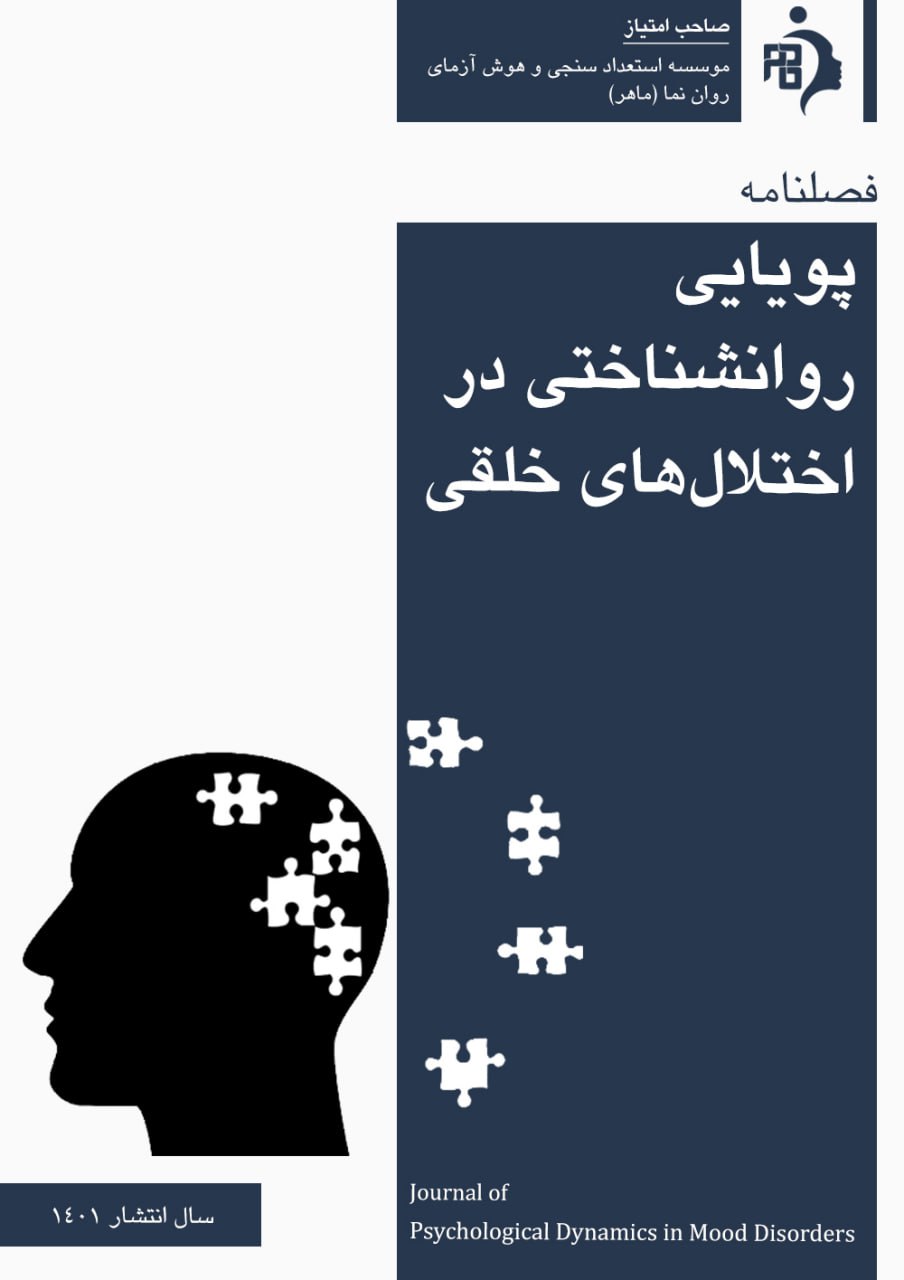ارائه الگوی مدل ساختاری بیموبایلهراسی بر اساس احساس تنهایی با میانجیگری پریشانی روانشناختی در دانشجویان
کلمات کلیدی:
احساس تنهایی, بیموبایلهراسی, پریشانی روانشناختی, دانشجویان, مدل ساختاریچکیده
هدف: هدف پژوهش حاضر تبیین مدل ساختاری بیموبایلهراسی بر اساس احساس تنهایی با نقش میانجی پریشانی روانشناختی در بین دانشجویان بود. روششناسی: این پژوهش از نوع توصیفی–همبستگی و مبتنی بر مدلیابی معادلات ساختاری بود. جامعه آماری شامل تمامی دانشجویان دانشکده تعلیم و تربیت اسلامی، گروه روانشناسی و مشاوره دانشگاه آزاد اسلامی واحد کرج در نیمسال دوم سال تحصیلی 1403–1404 بود. بر اساس مبانی نظری کلاین، حجم نمونه 250 نفر تعیین شد و با روش نمونهگیری در دسترس انتخاب گردید. ابزارهای گردآوری دادهها شامل پرسشنامه بیموبایلهراسی یلدریام و کوریا (2015)، پرسشنامه احساس تنهایی راسل (1996) و پرسشنامه پریشانی روانشناختی کسلر و همکاران (2002) بودند. دادهها با استفاده از نرمافزار SPSS نسخه 22 و AMOS نسخه 23 تحلیل شدند و برازش مدل با شاخصهایی نظیر χ²/df، GFI، AGFI، CFI، NFI و RMSEA ارزیابی گردید. یافتهها: نتایج نشان داد که احساس تنهایی تأثیر مثبت و معناداری بر پریشانی روانشناختی دارد (β = 0.59, p ≤ 0.001) و پریشانی روانشناختی نیز به طور معنادار بیموبایلهراسی را پیشبینی میکند (β = 0.65, p ≤ 0.001). همچنین، احساس تنهایی تأثیر مستقیم و مثبت بر بیموبایلهراسی داشت (β = 0.47, p ≤ 0.001). تحلیل بوتاستراپ نشان داد اثر غیرمستقیم احساس تنهایی بر بیموبایلهراسی از طریق پریشانی روانشناختی معنادار است (β = 0.38, p ≤ 0.001). شاخصهای برازش مدل (χ²/df = 2.258، GFI = 0.99، CFI = 0.97، RMSEA = 0.071) نشاندهنده برازش مطلوب مدل بودند. نتیجهگیری: احساس تنهایی بهصورت مستقیم و از طریق میانجیگری پریشانی روانشناختی در افزایش بیموبایلهراسی در میان دانشجویان نقش دارد. نتایج نشان میدهد که مداخلات آموزشی و روانشناختی که بر کاهش احساس تنهایی و پریشانی روانی متمرکز هستند، میتوانند راهبردی مؤثر برای کاهش بیموبایلهراسی و ارتقای سلامت روان در محیطهای دانشگاهی باشند.
دانلودها
مراجع
Abdoli, N., Bahmani, D., Salari, N., Khodamoradi, M., Farnia, V., Jahangiri, S., & Brand, S. (2023). Nomophobia (no mobile phone phobia) and psychological health issues among young adult students. European Journal of Investigation in Health Psychology and Education, 13(9), 1762–1775. https://doi.org/10.3390/ejihpe13090128
Aldalalah, O. (2020). Fear of losing the mobile phone nomophobia among students and its impact of psycho-loneliness and learning in the light of some variables. International Journal of Interactive Mobile Technologies, 14(16). https://doi.org/10.3991/ijim.v14i16.12797
Andrews, H., & Roque, N. (2024). The paradox of digital connectivity: comparing theories on loneliness and mobile phone dependence. Innovation in Aging, 8(Supplement_1), 1169–1170. https://doi.org/10.1093/geroni/igae098.3748
Anshari, M., Alas, Y., & Sulaiman, E. (2019). Smartphone addictions and nomophobia among youth. Vulnerable Children and Youth Studies, 14(3), 242–247. https://doi.org/10.1080/17450128.2019.1614709
Ayala, M. J., Alegre de la Rosa, O. M., Chambi Catacora, M. A. D. P., Vargas Onofre, E., Cari Checa, E., & Díaz Flores, D. (2025). Nomophobia, phubbing, and deficient sleep patterns in college students. Frontiers in Education, 9, 1421162. https://doi.org/10.3389/feduc.2024.1421162
Bassi, G., Embaye, J., Wit, M., Snoek, F., & Salcuni, S. (2023). The relationship between emotional self-awareness, emotion regulation, and diabetes distress among Italian and Dutch adults with type 1 diabetes. Frontiers in psychology, 14. https://doi.org/10.3389/fpsyg.2023.1288550
Bentley, S., Young, T., Álvarez, B., Jetten, J., Haslam, C., Cruwys, T., & Wibisono, S. (2022). Double jeopardy: how lower levels of support during COVID-19 exacerbated the relationship between loneliness and distress. Frontiers in Public Health, 10. https://doi.org/10.3389/fpubh.2022.976443
Choi, N. G., Sullivan, J. E., DiNitto, D. M., & Kunik, M. E. (2019). Associations between psychological distress and health-related behaviors among adults with chronic kidney disease. Preventive Medicine, 126, 105749. https://doi.org/10.1016/j.ypmed.2019.06.007
Chowdhury, N., Kevorkian, S., Hawn, S. E., Amstadter, A. B., Dick, D., Kendler, K. S., & Berenz, E. C. (2018). Associations between personality and distress tolerance among trauma-exposed young adults. Personality and individual differences, 120, 166–170. https://doi.org/10.1016/j.paid.2017.08.041
Courtin, É., & Knapp, M. (2015). Social isolation, loneliness and health in old age: a scoping review. Health & Social Care in the Community, 25(3), 799–812. https://doi.org/10.1111/hsc.12311
Durak, H. (2018). What would you do without your smartphone? Adolescents' social media usage, locus of control, and loneliness as a predictor of nomophobia. Addicta the Turkish Journal on Addictions, 5(3). https://doi.org/10.15805/addicta.2018.5.2.0025
Gezgin, D. M., Hamutoglu, N. B., Sezen-Gultekin, G., & Ayas, T. (2018). The relationship between nomophobia and loneliness among Turkish adolescents. International Journal of Research in Education and Science, 4(2), 358–374. https://doi.org/10.21890/ijres.409265
Gómez-Salgado, J., Andrés-Villas, M., Domínguez-Salas, S., Díaz-Milanés, D., & Ruiz-Frutos, C. (2020). Related health factors of psychological distress during the COVID-19 pandemic in Spain. International journal of environmental research and public health, 17(11), 3947. https://doi.org/10.3390/ijerph17113947
Güveli, R., Balci, E., & Bayraktar, M. (2024). Nomophobia, loneliness and depressive symptom levels of adults living in a district of Türkiye. Medicine, 103(31), e38921. https://doi.org/10.1097/MD.0000000000038921
Gyasi, R. M. (2019). Social support, physical activity and psychological distress among community-dwelling older Ghanaians. Archives of Gerontology and Geriatrics, 81, 142–148. https://doi.org/10.1016/j.archger.2018.11.016
Hamzaa, H., Atta, M., Omar, M., Machaly, E., Amin, S., & Wahba, N. (2024). Examining nursing students' prevalence of nomophobia, and psychological alienation and their correlates with fear of missing out: a multisites survey. Sage Open Nursing, 10. https://doi.org/10.1177/23779608241301223
Hussien, R. (2022). The association between nomophobia and loneliness among the general population in the Kingdom of Saudi Arabia. Middle East Current Psychiatry, 29(1). https://doi.org/10.1186/s43045-022-00235-8
Kara, M., Baytemir, K., & Inceman-Kara, F. (2021). Duration of daily smartphone usage as an antecedent of nomophobia: Exploring multiple mediation of loneliness and anxiety. Behaviour & Information Technology, 40(1), 85–98. https://doi.org/10.1080/0144929X.2019.1673485
Kessler, R. C., Andrews, G., Colpe, L. J., Hiripi, E., Mroczek, D. K., Normand, S. L., & Zaslavsky, A. M. (2002). Short screening scales to monitor population prevalences and trends in non-specific psychological distress. Psychological medicine, 32(6), 959–976. https://doi.org/10.1017/S0033291702006074
Khan, M., & Mahmood, Z. (2024). Social engagement and psychological distress in institutionalized older adults: a mediating role of loneliness. Journal of Postgraduate Medical Institute. https://doi.org/10.54079/jpmi.38.2.3303
Kukreti, S., Ahorsu, D., Strong, C., Chen, I., Lin, C., Ko, N., & Pakpour, A. (2021). Post-traumatic stress disorder in Chinese teachers during COVID-19 pandemic: roles of fear of COVID-19, nomophobia, and psychological distress. Healthcare, 9(10), 1288. https://doi.org/10.3390/healthcare9101288
Lai, H., Mei, X., Huang, S., Wu, X., Liang, J. Q., Zhou, L., & Ye, Z. J. (2025). The Relationship Between Smartphone Addiction and Sleep Quality in Older Adults: The Mediating Role of Loneliness and Depression. BMC Nursing, 24(1). https://doi.org/10.1186/s12912-025-02883-7
Mozaffari, M., & Gheirati, S. (2023). Predicting nomophobia based on the roles of self-esteem and loneliness among young adults. Proceedings of the 1st International Conference on Psychology, Social Sciences, Educational Sciences, and Philosophy. https://civilica.com/doc/1698579/
Peper, E., & Harvey, R. (2018). Digital addiction: Increased loneliness, anxiety, and depression. NeuroRegulation, 5(1), 3–3. https://doi.org/10.15540/nr.5.1.3
Poushter, J., Bishop, C., & Chwe, H. (2018). Social media use continues to rise in developing countries but plateaus across developed ones. Pew Research Center, 22, 2–19. https://www.pewresearch.org/global/2018/06/19/social-media-use-continues-to-rise-in-developing-countries-but-plateaus-across-developed-ones/
Prasad Parajuli, K., Rana, K., & Laudari, S. (2024). Teachers' use of mobile devices in suburban under-resourced secondary schools in Nepal. Distance Education, 45(4), 606–626. https://doi.org/10.1080/01587919.2024.2379831
Rodríguez-García, A. M., Moreno-Guerrero, A. J., & Lopez Belmonte, J. (2020). Nomophobia: An individual's growing fear of being without a smartphone-a systematic literature review. International journal of environmental research and public health, 17(2), 580. https://doi.org/10.3390/ijerph17020580
Russell, D. W. (1996). UCLA Loneliness Scale (Version 3): Reliability, validity, and factor structure. Journal of Personality Assessment, 66(1), 20–40. https://doi.org/10.1207/s15327752jpa6601_2
Shambare, R., Rugimbana, R., & Zhowa, T. (2012). Are mobile phones the 21st century addiction? African journal of business management, 6(2), 573. https://doi.org/10.5897/AJBM11.1940
Sheikh, B., Hariri, N., Alqahtani, M., Aljabri, A., Eterji, A., Almutawa, S., & Alhejaili, A. (2024). Prevalence and associated factors of nomophobia amongst the general population in Makkah province and Al-Madinah province, Saudi Arabia: an analytical cross-sectional study. Clinical Practice and Epidemiology in Mental Health, 20(1). https://doi.org/10.2174/0117450179311620240508105100
Soraci, P., Demetrovics, Z., Bevan, N., Pisanti, R., Servidio, R., Bernardo, C. D., Chini, E., & Griffiths, M. D. (2025). FoMO and Psychological Distress Mediate the Relationship Between Life Satisfaction, Problematic Smartphone Use, and Problematic Social Media Use. International journal of mental health and addiction. https://doi.org/10.1007/s11469-024-01432-8
Szkody, E., Stearns, M., Stanhope, L., & McKinney, C. (2020). Stress-buffering role of social support during COVID-19. Family Process, 60(3), 1002–1015. https://doi.org/10.1111/famp.12618
Teasdale, T. W., & Antal, K. (2016). Psychological distress and intelligence in young men. Personality and individual differences, 99, 336–339. https://doi.org/10.1016/j.paid.2016.05.016
Terzi, H., Ayaz-Alkaya, S., & Köse-Kabakcıoğlu, N. (2024). Nomophobia and eHealth literacy among adolescents: A cross-sectional study. Journal of Pediatric Nursing, 75, 158-163. https://doi.org/10.1016/j.pedn.2023.12.024
Valenti, G., Bottaro, R., & Faraci, P. (2022). Effects of difficulty in handling emotions and social interactions on nomophobia: examining the mediating role of feelings of loneliness. International journal of mental health and addiction, 22(1), 528–542. https://doi.org/10.1007/s11469-022-00888-w
Walsh, S. P., White, K. M., & Young, R. M. (2010). Needing to connect: The effect of self and others on young people's involvement with their mobile phones. Australian Journal of Psychology, 62(4), 194–203. https://doi.org/10.1080/00049530903567229
Yildirim, C., & Correia, A. P. (2015). Exploring the dimensions of nomophobia: Development and validation of a self-reported questionnaire. Computers in human Behavior, 49, 130–137. https://doi.org/10.1016/j.chb.2015.02.059
دانلود
چاپ شده
ارسال
بازنگری
پذیرش
شماره
نوع مقاله
مجوز
حق نشر 2025 معین غنیزاده خواجه پاشا, محمدرضا بلیاد, محسن منصوبیفر, معصومه ژیان باقری, جاوید پیمانی (Author)

این پروژه تحت مجوز بین المللی Creative Commons Attribution-NonCommercial 4.0 می باشد.









